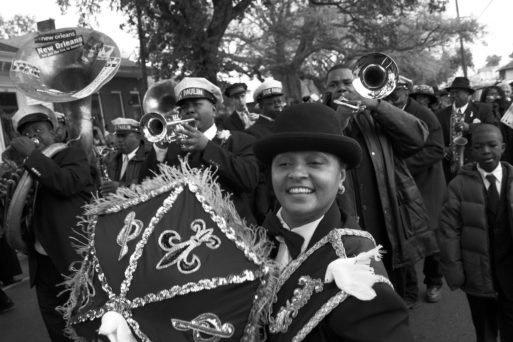Few burial traditions are more distinct than the New Orleans jazz funeral. Born of West African traditions brought to America by slaves and blended with European military tradition, few images evoke quintessential New Orleans culture quite like a jazz funeral. And no jazz funeral is complete without a vibrant and raucous second line.
Though the second line has become an art form that is no longer associated strictly with funerals, it’s a unique tradition that came to be what it is because of its historical roots in ancient burial rituals and because of New Orleans’ history of slavery. And yes, also because of that sweet New Orleans jazz that seems to live and breathe in the architecture and the streets of NOLA.

Image Credit:
Artsneworleans.org
African Roots: Second Circle to Second Line
The tradition of the second line can be traced back to West African circle dances, in which children danced in a second circle around the main circle of adults. These dances came to New Orleans via the Middle Passage, where they were incorporated into funeral processions, and the rings of dancers became lines of dancers.
Community Traditions are Born
As slavery was abolished, funeral processions with European-style brass bands became popular among prominent members of the black community in New Orleans. This popularity was aided, ironically, by insurance companies that refused to sell policies to freed slaves. This led to the formation of New Orleans’ famous “Social Aid and Pleasure Clubs,” which usually offered dues-paying members a brass band for their funerals, and also organized annual parades for the enjoyment of their communities.
Jazz Becomes the Heart of the Celebration
With the 20th century came the advent of jazz, and the proper New Orleans jazz funeral was born. Funeral processions of this kind had followed a very old format up to this point — dirges on the way to the burial, with more jubilant music on the procession away from the grave (all performed by a European-style military brass band much like those of the French at the time). With the coming of jazz, however, this ritual would become a cultural phenomenon unlike any other, and the second line would develop as an art form in itself.

Image Credit:
Flickr.com
Modern Jazz Funerals and the Second Line
As they have grown in popularity and recognition throughout the 20th century, jazz funerals (particularly second lines) have become known as a way to be a part of the vibrant culture of this great town. The modern jazz funeral consists of two “lines,” the first line being primarily family members of the deceased, club officials and the band. The second line is a group of mourners/revelers that assembles behind the first line—usually marching solemnly to the grave, then dancing and celebrating on the route away from the grave.
These funerals, while not as wild and colorful as the famed Mardis Gras parades, are truly something to behold and be a part of. With the polyrhythmic drumming and the tuba urging crowds along as strongly as the tide, it’s almost instinctual to go from bystander to second liner when one of these parades comes along. The singing trumpets lauding the virtue of a life well-lived, and the energy and inspiration created by this celebration of life affirm the real soul of New Orleans in a way that really must be seen to be understood.
So if you find yourself in New Orleans and you hear the sounds of jazz funeral approaching, stop what you’re doing and witness a truly incredible display of culture and celebration you’ll never see anywhere else. And if you feel an urge to join in, just follow the leads from the other second liners and, when it’s time to dance, remember you’re dancing to celebrate someone’s life. Give yourself over to the rhythm and dance, dance, dance.

 The Second Line Tradition of the New Orleans Jazz Funeral
The Second Line Tradition of the New Orleans Jazz Funeral


 How Dare You Die Now!
How Dare You Die Now!
 Debating Medical Aid in Dying
Debating Medical Aid in Dying
 “Help Me, Helen”
“Help Me, Helen”














